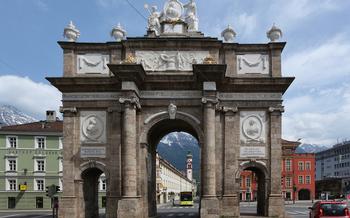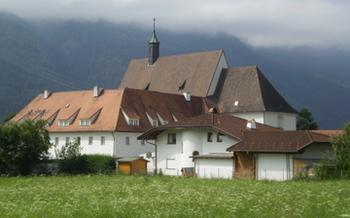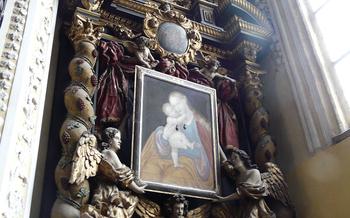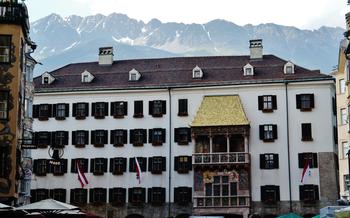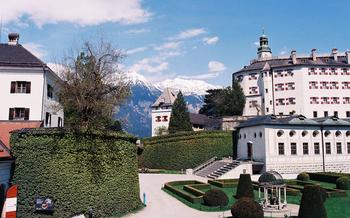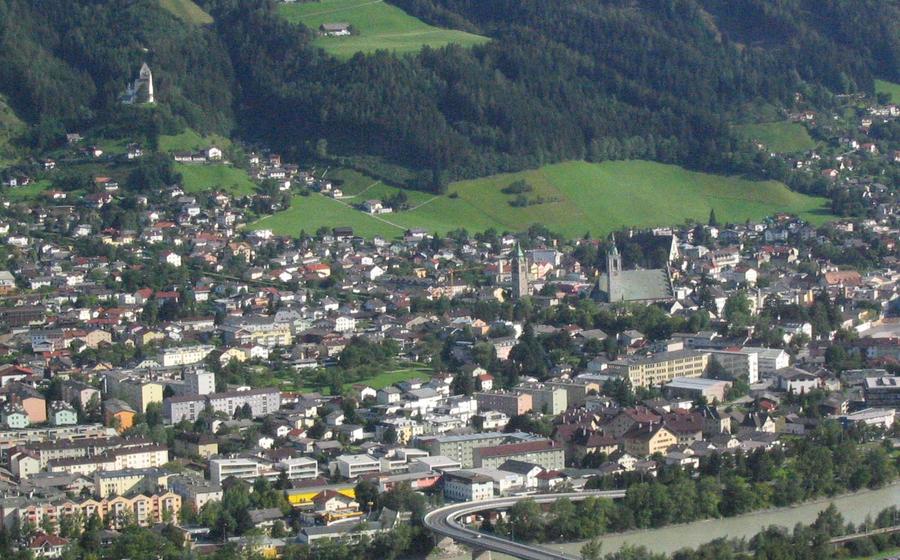
Museum Goldenes Dachl
- The Golden Roof in the Heart of Innsbruck's Old Town
- Exploring the Imperial History of Tyrol
- Masterful Craftsmanship and Artistic Detail
- A Glimpse into Medieval Life and Customs
- The Golden Roof in Literature and Art
- The Stunning Views from the Observation Deck
- Interactive Exhibitions and Multimedia Displays
- Guided Tours and Audio Guides
- The Golden Roof in Local Folklore and Legends
- The Golden Roof as a Symbol of Innsbruck
- The Golden Roof in Modern Culture and Contemporary Art
- The Golden Roof's Contribution to UNESCO World Heritage Status
- Visiting the Golden Roof: Practical Information
- The Golden Roof's Role in Local Festivals and Events
- Insider Tip:
The Golden Roof in the Heart of Innsbruck's Old Town
In the heart of Innsbruck's Old Town, a magnificent architectural masterpiece commands attention - the Golden Roof, a testament to the city's rich history and artistic heritage. This iconic landmark, with its shimmering fire-gilded copper tiles, has become a defining symbol of Innsbruck and a must-see attraction for visitors worldwide.
The Golden Roof, known locally as "Goldenes Dachl," is a magnificent sight to behold. Constructed in the early 16th century under the reign of Emperor Maximilian I, this elaborate balcony adorns the facade of the Neues Hofburg, the former imperial palace. Its intricate design, featuring 2,657 fire-gilded copper tiles, is a testament to the exceptional craftsmanship and artistic vision of the era.
Each tile, meticulously crafted and adorned with intricate motifs, tells a story of the Habsburg dynasty, their reign, and the rich history of Tyrol. The roof's golden glow, shimmering in the sunlight, creates a breathtaking spectacle, earning it the title of "Golden Roof" and making it one of the most recognizable landmarks in Austria.
The Golden Roof's location within the vibrant Old Town of Innsbruck adds to its allure. Nestled amidst cobblestone streets, charming cafes, and historic buildings, this architectural gem seamlessly blends with its surroundings, creating a picturesque urban landscape. Visitors can wander through the Old Town's narrow alleyways, marveling at the medieval architecture and soaking in the city's unique atmosphere, before emerging in the bustling square dominated by the resplendent Golden Roof.
This iconic landmark holds a special significance for the people of Innsbruck and is deeply intertwined with the city's identity. It represents the grandeur of the Habsburg era, the artistry and craftsmanship of Tyrolean masters, and the enduring legacy of a rich cultural heritage. The Golden Roof stands as a symbol of pride, resilience, and the enduring spirit of the Tyrolean people.
Exploring the Imperial History of Tyrol
The Golden Roof stands as a testament to the imperial history of Tyrol, a region that was ruled by the Habsburg dynasty for over 600 years. The Habsburgs were one of the most powerful and influential families in Europe, and their reign over Tyrol left a lasting legacy on the region's culture, politics, and architecture.
The Golden Roof was commissioned by Emperor Maximilian I, who was a keen patron of the arts and architecture. He wanted to create a symbol of his power and wealth, and the Golden Roof was the perfect way to do it. The roof is covered in 2,657 fire-gilded copper tiles, which shimmer and shine in the sunlight. The tiles are arranged in intricate patterns, and they depict scenes from the life of Emperor Maximilian and his family.
The Golden Roof is a reminder of the Habsburg dynasty's long and illustrious reign over Tyrol. It is a symbol of their power, wealth, and influence, and it is a testament to their lasting legacy on the region.
Some of the notable personalities associated with the imperial history of Tyrol include:
- Emperor Maximilian I: The Holy Roman Emperor who commissioned the Golden Roof.
- Empress Maria Theresa: The Habsburg ruler who introduced many reforms to Tyrol.
- Andreas Hofer: The Tyrolean rebel leader who fought against Napoleon's occupation of the region.
Some of the key events in the imperial history of Tyrol include:
- The Tyrolean Rebellion of 1809: A popular uprising against Napoleon's occupation of Tyrol.
- The Congress of Vienna: The peace conference that restored Tyrol to the Habsburgs after the Napoleonic Wars.
- The Anschluss: The annexation of Austria by Nazi Germany in 193
Masterful Craftsmanship and Artistic Detail
The Golden Roof is a testament to the extraordinary craftsmanship and meticulous attention to detail that characterized medieval artisans. The roof's 2,657 fire-gilded copper tiles were individually handcrafted using a complex and intricate process. Each tile was first hammered into shape, then coated with a thin layer of gold leaf. The tiles were then fired in a kiln, a process that fused the gold to the copper and created a durable and lustrous finish.
The roof's intricate motifs and decorative elements further showcase the artistry and skill of its creators. The tiles are arranged in a variety of patterns, including geometric designs, floral motifs, and depictions of animals and mythical creatures. The roof's central feature is a large double-headed eagle, the symbol of the Habsburg dynasty. The eagle is surrounded by a frieze of smaller eagles, each of which is unique in its design.
The symbolism and meanings behind the various decorative elements add to the roof's artistic and cultural significance. The double-headed eagle represents the power and authority of the Habsburgs, while the smaller eagles symbolize the unity and strength of the empire. The floral motifs represent fertility and abundance, while the animals and mythical creatures symbolize the diversity and richness of the natural world.
The Golden Roof is a masterpiece of medieval craftsmanship that continues to inspire and amaze visitors from around the world. The intricate details and masterful artistry of the roof make it a true work of art and a testament to the skill and ingenuity of the craftsmen who created it.
A Glimpse into Medieval Life and Customs
The Golden Roof offers a captivating glimpse into the lifestyle, customs, and traditions of medieval Innsbruck. It stands as a testament to the grandeur and opulence of the Habsburg court, providing insights into the daily lives of the ruling elite and the people of the city. The intricate carvings and decorations on the roof depict scenes from medieval life, offering a glimpse into the social hierarchy, religious beliefs, and cultural practices of the time.
The Golden Roof's location in the heart of the Old Town further enhances its significance as a symbol of medieval heritage. The narrow cobblestone streets, quaint buildings, and bustling markets surrounding the Golden Roof transport visitors back in time, creating an immersive experience that allows them to imagine the sights, sounds, and smells of medieval Innsbruck.
The Golden Roof's historical and cultural significance is comparable to other medieval landmarks across Europe. Like the Tower of London in England or the Louvre Museum in France, the Golden Roof stands as a testament to the architectural achievements, artistic prowess, and historical legacy of its era. It invites visitors to explore the rich tapestry of medieval life, customs, and traditions, offering a profound understanding of the roots of European culture and history.
The Golden Roof in Literature and Art
The Golden Roof has served as a muse for artists and writers throughout history, inspiring countless works of literature, paintings, and other art forms. The intricate beauty and historical significance of the landmark have captured the imaginations of creatives worldwide, leading to diverse interpretations and representations.
In literature, the Golden Roof features prominently in historical novels and travelogues, serving as a backdrop for tales of romance, intrigue, and adventure. Notable authors such as Mark Twain, Charles Dickens, and Herman Melville have described the Golden Roof in their writings, marveling at its architectural grandeur and evoking its historical charm.
In the realm of art, the Golden Roof has been immortalized in paintings, sketches, and engravings by renowned artists. The most famous depiction is perhaps Albrecht Dürer's watercolor painting from 1495, which captures the intricate details of the roof and offers a glimpse into the life of the Habsburg court. Other notable artists who have featured the Golden Roof in their works include Franz Defregger, Josef Anton Koch, and Carl Spitzweg.
The Golden Roof's cultural significance extends beyond its historical and architectural value, as it has become an iconic symbol of Innsbruck and a source of inspiration for contemporary artists. Its enduring legacy in literature and art underscores its status as a cherished cultural landmark that continues to captivate hearts and minds to this day.
The Stunning Views from the Observation Deck
Ascend to the observation deck atop the Golden Roof to be rewarded with breathtaking panoramic vistas of Innsbruck. This vantage point unveils a tapestry of architectural wonders, verdant mountains, and the vibrant cityscape. Gaze upon the majestic Nordkette mountain range, its peaks piercing the azure sky like ancient sentinels guarding the city. Follow the meandering Inn River as it gracefully weaves its way through the heart of Innsbruck, reflecting the golden hues of the setting sun.
Spot iconic landmarks such as the Hofburg Imperial Palace, with its opulent facade and centuries of history etched into its walls. Marvel at the intricate spires of the Gothic Cathedral of St. James, reaching towards the heavens in a testament to the city's spiritual heritage. Capture the vibrant energy of Maria-Theresien-Straße, a bustling pedestrian zone lined with elegant boutiques, charming cafes, and lively street performers.
The observation deck offers a unique perspective, allowing you to appreciate Innsbruck's harmonious blend of history, nature, and modern urban life. Whether you're a seasoned traveler or a first-time visitor, the stunning views from the Golden Roof will leave an indelible impression, forever etching Innsbruck into your travel memories.
Interactive Exhibitions and Multimedia Displays
The Golden Roof offers a modern and engaging experience through its interactive exhibitions and multimedia displays. These exhibitions showcase the history, significance, and cultural context of the landmark in a captivating manner. Visitors can delve into the past through historical artifacts, interactive displays, and multimedia presentations. The exhibitions provide insights into the construction, symbolism, and the role of the Golden Roof in the Habsburg dynasty and Tyrolean history.
The use of multimedia technology enhances the visitor experience, making the history of the Golden Roof come alive. Interactive touchscreens, audio-visual presentations, and augmented reality displays offer an immersive and educational journey. Visitors can explore the intricate details of the fire-gilded copper tiles, learn about the lives of the Habsburg rulers, and discover the legends and folklore associated with the Golden Roof.
These interactive exhibitions and multimedia displays cater to visitors of all ages and interests. They provide an engaging and informative way to explore the rich history and cultural heritage of the Golden Roof, making it a must-visit destination for anyone interested in Austrian history and architecture.
Guided Tours and Audio Guides
Enhance your visit to the Golden Roof with a guided tour or audio guide. Knowledgeable guides bring the history and significance of this iconic landmark to life, sharing insights and anecdotes that enrich the experience. Guided tours are available in multiple languages, ensuring accessibility for visitors from around the world. Audio guides offer a self-paced alternative, allowing you to explore at your own leisure while listening to informative commentary. Choose the option that best suits your preferences and interests to make the most of your visit to the Golden Roof.
The Golden Roof in Local Folklore and Legends
The Golden Roof is not just a historical monument but also a source of local folklore and legends that have shaped the cultural identity of Innsbruck. One popular legend tells of a hidden treasure buried beneath the Golden Roof, said to be a vast fortune stashed away by the Habsburgs during their reign. Another legend revolves around a royal scandal, where a Habsburg prince was caught in a secret affair with a commoner and was banished from the city.
One of the most intriguing legends associated with the Golden Roof is the tale of the "Golden Man." According to the story, a golden statue once stood atop the roof, symbolizing the power and wealth of the Habsburgs. However, during a thunderstorm, the statue was struck by lightning and vanished, leaving behind only a golden footprint on the roof. Locals believe that the statue will return one day, bringing good fortune to the city.
These legends and stories add a layer of mystery and charm to the Golden Roof, making it not just a historical landmark but also a symbol of Innsbruck's rich cultural heritage. They remind visitors of the city's fascinating past and the power of storytelling in shaping local identity.
The Golden Roof as a Symbol of Innsbruck
The Golden Roof has become an iconic symbol of Innsbruck, recognized worldwide for its unique architecture and historical significance. It is a prominent landmark that attracts countless tourists each year, eager to witness its splendor and learn about its rich history. The Golden Roof's presence on postcards, souvenirs, and promotional materials has further cemented its status as a symbol of the city, helping to promote Innsbruck as a popular tourist destination.
Similar to other iconic landmarks such as the Eiffel Tower in Paris or the Statue of Liberty in New York City, the Golden Roof has become synonymous with Innsbruck. It is a symbol of the city's rich cultural heritage, imperial past, and architectural prowess. The Golden Roof's distinctive appearance and historical significance have made it an instantly recognizable symbol, representing Innsbruck's unique identity and charm.
The economic and cultural benefits of having such a recognizable symbol are substantial. The Golden Roof attracts a steady stream of tourists to Innsbruck, contributing to the city's economy and supporting local businesses. It also serves as a source of pride for the people of Innsbruck, who cherish their city's unique landmark and its representation of their cultural heritage. The Golden Roof's status as a symbol of Innsbruck has undoubtedly played a significant role in promoting the city as a must-visit destination for travelers worldwide.
The Golden Roof in Modern Culture and Contemporary Art
The Golden Roof's iconic status extends beyond its historical and architectural significance, inspiring contemporary artists and cultural expressions. In modern art, the Golden Roof has been reinterpreted through various mediums, including art installations, street art, and pop culture references. These contemporary representations reflect modern perspectives on history and culture, showcasing the enduring influence of the Golden Roof.
One notable example is the art installation "The Golden Roof Revisited" by Austrian artist Erwin Wurm, which presents a playful and humorous take on the landmark. Wurm's installation features a series of oversized, inflatable golden roofs placed in unexpected locations around Innsbruck, challenging traditional notions of historical preservation and inviting viewers to engage with the Golden Roof in a new way.
In the realm of street art, the Golden Roof has become a canvas for creative expression. Local and international artists have created murals and graffiti depicting the landmark, often incorporating modern elements and social commentary. These vibrant street art pieces add a contemporary layer to the city's historical tapestry, demonstrating the Golden Roof's relevance to contemporary urban culture.
The Golden Roof's influence extends to popular culture as well, appearing in films, television shows, and literature. In the popular Austrian TV series "Der Bergdoktor," the Golden Roof serves as a backdrop for various scenes, showcasing its iconic status as a symbol of Innsbruck.
These contemporary interpretations of the Golden Roof underscore its enduring significance as a source of inspiration and creativity. By engaging with the Golden Roof through modern art and culture, visitors can gain a deeper understanding of its historical and cultural relevance while appreciating its continued influence on contemporary society.
The Golden Roof's Contribution to UNESCO World Heritage Status
Innsbruck, with its rich cultural heritage and architectural wonders, was designated as a UNESCO World Heritage Site in 200The Golden Roof played a pivotal role in this prestigious recognition, as it is considered a remarkable example of medieval architecture and craftsmanship.
The UNESCO World Heritage Committee recognized Innsbruck's outstanding universal value based on several criteria. Firstly, the city's historic center, where the Golden Roof is prominently situated, represents a unique example of a well-preserved medieval city that has successfully adapted to modern times.
Secondly, the Golden Roof itself is an exceptional testament to the artistic and technological achievements of the late Middle Ages. Its intricate design, fire-gilded copper tiles, and meticulous attention to detail showcase the exceptional skills of medieval artisans.
Furthermore, the Golden Roof holds significant historical and cultural value. As a symbol of the Habsburg dynasty's power and wealth, it offers insights into the political and social dynamics of medieval Europe. It also serves as a reminder of Innsbruck's role as a significant trading center and a meeting point of different cultures.
Innsbruck's designation as a UNESCO World Heritage Site not only recognizes the city's cultural and historical importance but also highlights the Golden Roof's contribution to the world's cultural heritage. This prestigious status underscores the need to preserve and protect this architectural masterpiece for future generations.
Other UNESCO World Heritage Sites in Austria include the historic center of Salzburg, the Schönbrunn Palace and Gardens in Vienna, and the Hallstatt-Dachstein/Salzkammergut Cultural Landscape. These sites, along with the Golden Roof, showcase the diverse cultural heritage and natural wonders that Austria has to offer.
Visiting the Golden Roof: Practical Information
Before embarking on your journey to marvel at the Golden Roof, it is essential to equip yourself with practical information to ensure a seamless and rewarding experience. The Golden Roof is open to the public, welcoming visitors throughout the year. However, opening hours may vary depending on the season, so it is advisable to check the official website or contact the local tourist information office for up-to-date information.
Admission fees are typically charged for entry into the Golden Roof, allowing visitors to explore the museum and learn about its captivating history. Various ticket options may be available, including reduced rates for students, seniors, and families. It is recommended to purchase tickets in advance, especially during peak tourist season, to avoid long queues and secure your spot.
Accessibility is a priority at the Golden Roof, ensuring that visitors with disabilities can fully enjoy the experience. Wheelchair ramps and accessible restrooms are available, enabling everyone to marvel at the splendor of this iconic landmark. It is advisable to inform the staff of any specific requirements or assistance needed to ensure a comfortable visit.
Planning your visit to the Golden Roof is essential to make the most of your time. To avoid the throngs of tourists, consider visiting during the shoulder seasons (spring and autumn) or on weekdays when crowds are generally smaller. Audio guides are available in multiple languages, offering an immersive experience and providing in-depth insights into the history and significance of the Golden Roof.
The recommended duration for a visit to the Golden Roof is approximately one hour. However, if you are particularly interested in delving deeper into the history and cultural context, you may wish to allocate more time for your visit. There are various nearby attractions, such as the Hofburg Imperial Palace and the Innsbruck Cathedral, which can be easily combined with a visit to the Golden Roof to create a comprehensive cultural itinerary.
The Golden Roof's Role in Local Festivals and Events
The Golden Roof is not just a historical monument but also an integral part of Innsbruck's vibrant cultural scene. Throughout the year, the Golden Roof serves as a backdrop for various local festivals and events, adding to the city's festive atmosphere.
One of the most notable events associated with the Golden Roof is the Innsbruck Medieval Festival. Held annually in June, this festival transports visitors back in time to the Middle Ages with its colorful parades, historical reenactments, and medieval market stalls. The Golden Roof takes center stage during the festival, with costumed performers and musicians bringing its history to life.
Another popular event is the Innsbruck Christmas Market. During this festive season, the Golden Roof is adorned with twinkling lights and festive decorations, creating a magical ambiance. Visitors can stroll through the charming market stalls set up around the Golden Roof, savoring traditional Austrian delicacies and enjoying live music performances.
The Golden Roof also plays a role in the city's cultural events. Throughout the year, various concerts, art exhibitions, and performances take place in the vicinity of the Golden Roof, creating a vibrant cultural hub in the heart of Innsbruck.
Attending these festivals and events is a wonderful way to experience the rich cultural heritage of Innsbruck and witness the Golden Roof in all its glory. Immerse yourself in the medieval atmosphere, savor the festive spirit, and enjoy the vibrant cultural offerings that make Innsbruck a truly unforgettable destination.
Insider Tip:
For a truly unique perspective of the Golden Roof, head to the observation deck of the nearby City Tower (Stadtturm). This 14th-century tower offers panoramic views of Innsbruck's Old Town, with the Golden Roof taking center stage. Capture stunning photographs of the landmark against the backdrop of the Nordkette mountains, especially during sunset when the sky is ablaze with colors. Don't miss the opportunity to explore the City Tower itself, which houses a fascinating museum showcasing the history of Innsbruck and its iconic Golden Roof.

